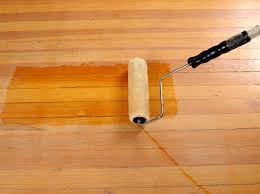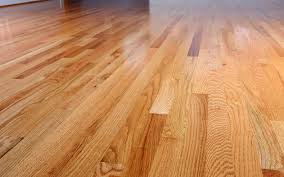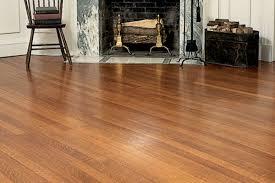Do hardwood floors need to be sealed?
There is a balance in creating a perfect finish that is both durable and beautiful. Maintaining this balance can often make the difference between a masterpiece that brings a room together, or a disaster that requires hours of work and tons of money to fix. It all starts with choosing and applying the right sealer. When you properly seal your hardwood floors, you lay the foundation for creating a stunning appearance that will stand the test of time. Here are a few reasons why sealing your hardwood floor is so important.
Prevents Reactions to the Wood from the Finish
You spend time and money putting down the perfect hardwood flooring. You chose the perfect hardwood and the installation was a breeze. You apply the finish but do not seal. Disaster strikes. Instead of bringing your room together, they are an eyesore you are embarrassed to show to your family and friends. How could this disaster have been prevented? By using a sealer. When you seal your hardwood floors correctly, you prevent the wood from reacting with the finish. The chemicals in the finish can damage the wood and leave your beautiful hardwood floors looking like a beautiful mess.
Prevents Particles from the Wood Mixing with the Finish
One of the best qualities of hardwood flooring is its natural beauty. You selected hardwood flooring for your home or business because of its organic qualities. Because it was once alive, it still possesses plant particles that can be pulled out of its structure. These tannins and extractives can mix with the finish. When they mix together, the extracts can cause the finish to discolor and even prevent it from adhering to the wood. This is especially true if you are using wood that is oily in nature. By sealing your hardwood flooring, you can prevent the rich, desired color from changing, and by using a sealant you will ensure that the finish binds with the wood.
Builds a Solid Base for the Finish
When you apply a finish to untreated wood, it will soak into the wood. This soaking effect can not only damage your hardwood floors, but it can also increase the amount of finish you need to complete the job. By sealing the wood first, you supply a base for the finish to sit upon. With the finish sitting on top of the wood, there is a barrier that is created between the floor and the finish. This barrier helps to protect the wood from damage and increases the life of the finish. Not to mention that the less finish you use, the less money you will have to pay to get the desired result you are looking for.
Helps Produce the Perfect Color
The appearance and color of the hardwood can easily change during the staining and refinishing process. For this reason, using a sealer is imperative to achieving the desired color. Using a sealer gives you several options for how you want your hardwood floor to look. Sealers can be used to change or preserve the natural color of your wood floors. They can also be used to give your wood a three-dimensional look that cannot be accomplished by using finish alone. With the expanding number of paint options available for walls, homeowners are equally looking for numerous color options for their floors. Using a sealer allows for greater diversification of color options. Color options from greys and rich blacks to whitewash and natural are now available because of sealers

Oil and Water
Beyond the application of stain and/or sealer, it’s essential to apply a water- or oil-based finish to protect the wood. The choice depends on the type of wood, desired results, color and grain pattern. Neely notes these distinctions in polyurethane finishes (as well as the fact that floor installers usually have strong preferences about one kind or the other):
Water-Based
- These fast drying, water-based finishes need to be applied with focus to avoid brush or lap marks.
- They let the natural color of the wood come through.
- Many flooring professionals consider water-based finishes to be superior to oil-based finishes.
- They are often recommended for many types of exotic woods.
- Because they are water-based, they are considered environmentally responsible.
Oil-Based
- Oil-based polyurethane finishes add more color and depth to most woods: an ambering, yellow effect over light woods while darkening the hue of stained and dark woods.
- They are more forgiving than water-based when application is uneven.
- The drying time is 12 to 24 hours, so plan accordingly.
- Oil-based finishes enhance the wood of species such as walnut and red birch. (Water-based finishes can wash out rich, dark woods.)
- Hand-rubbed finishes occasionally are used on special wood. Tung oil is an alternative for rustic or reclaimed-wood floors to get a natural look.
- Neely adds that satin finishes are an overwhelmingly popular choice. “A low sheen offers a natural look that shows less wear. High gloss will show wear easily.”
- Beyond the manufacturer’s recommendations, Neely recommends that contractors who are unsure about the type of finish or care instructions contact a flooring expert.

Types of Finishes for a Hardwood Floor
The type of finish you choose depends on the look you want for your floor. Durability is also an issue. Your choices are
- Polyurethane: Either oil- or water-based, polyurethane comes in various degrees of luster and has a sort of plastic look. Both finish types darken or even yellow wood, although some newer water-based products don’t darken as much. Poly finishes are excellent for high-traffic and high-moisture areas. However, if the finish gets nicked or gouged, it’s extremely difficult to spot-repair.
- Varnish: Varnish comes in a variety of lusters, from matte to glossy. The higher the gloss, the more durable the surface. Varnish often darkens with age. On the up side, you can make spot-repairs to varnish.
- Penetrating sealer: This offers a natural-looking finish that brings out the wood’s grain; however, it may darken over time. Penetrating sealer offers good protection, especially when waxed. However, it’s less durable than polyurethane or varnish. It’s the easiest of the three to spot-repair, though.
Ideally, you want to seal the floor on the same day you finish sanding to prevent the open wood surface from absorbing moisture. For best results, apply the stain (if desired) and sealer with a sheepskin applicator. Be sure to apply the sealer evenly, and use enough to cover the surface. But be careful not to apply too much. Excess sealer doesn’t soak into the wood — it pools on the surface. If you fail to remove it, it leaves an ugly, ugly spot.

How to Clean Hardwood Flooring Safely
No matter what type of sealer or finish your hardwood has, the basic cleaning rules are the same. Above all, avoid excess moisture when cleaning, and always wipe up liquid spills and pooled water immediately. There’s no need wet-mop or steam clean a wood floor, and both of these methods can damage the wood.
The most important cleaning objective is to keep the floor free of dirt and grit, which scratches and dulls the finish as the floor is walked on. Sweeping or vacuuming regularly is the best way to keep a finish in good shape over the years. It’s ideal to sweep or vacuum daily, or at least every few days. Vacuum with a hard flooring attachment on a canister vacuum or a use the hard flooring setting (with no beater bar motion) on an upright vacuum.
If the floor needs deeper cleaning, use a towel or cloth or a sponge or microfiber mop (don’t use a string mop, which retains too much water) slightly dampened with warm water. Move the mop parallel to the floor boards, and rinse frequently, making sure to wring out the mop thoroughly each time. Finally, dry the floor with a towel to remove any residual moisture.
How You Will Benefit By Having Your Engineered Wood Floors Sealed
- Reduce the costs related to water damage repair
Water damage repair can be costly, time-consuming and stressing. Your floors might need more than one repair to bring back the new look, but this is never a guarantee. The point is, you might have to spend more than the initial cost required for engineered hardwood floors installation. Sealing your hardwood flooring protects your floors from leaks and spills of water that may lead to unnecessary water damage repair costs.
- Maintain the charming look for an extended time
One of the reasons you might want to consider engineered hardwood floors installation is the beauty in it. But what good is that charming look when it can be ruined in time? Sealing your floors leaves a water-resistant coating on your hardwood flooring. This coating prevents the water from soaking and damaging your hardwood flooring. But not only that. A proper seal will also add some sparkling look making your home look beautiful.
- You won’t need to replace it anytime sooner
Water damage repair and replacement costs can be expensive. It will soak your floors, leaving stains and splits that will spoil the charming look of your hardwood flooring. The last thing you want to do is replacing your floors sooner after the installation. Sealing your floors will keep your engineered floors installation intact for a longer period. It adds a protective layer that prevents your floors from absorbing water leaks and spills that may damage your floors.
- It is affordable
One great advantage of having your hardwood flooring sealed is, it doesn’t take too much. You only need a few dollars to seal up to 10 meters of your floor, which is much lower than replacements and water damage repair costs. So, why would you want to spend more when you have a better option? None. Sealing your hardwood floor doesn’t just add some charming look. It also helps maintain the initial look for a longer time at an affordable price.
- Increases the value of your property
Who wants to buy a home with damaged floors? Many home buyers will use your flooring to value your house. They’ll be looking for dents, splits or anything that might give them an excuse for wanting to pay lower claiming they will have to repair it later. Besides, repairs are stressing and time-consuming. Sealing your hardwood flooring adds value to your property. It will prevent the water leaks from soaking, splitting and leaving stains on your floors that might compromise its value. A properly maintained and sparkling clean floor might be profiting, especially if you have plans of selling your house later. In fact, it is also one of the tricks to get your house rented faster.